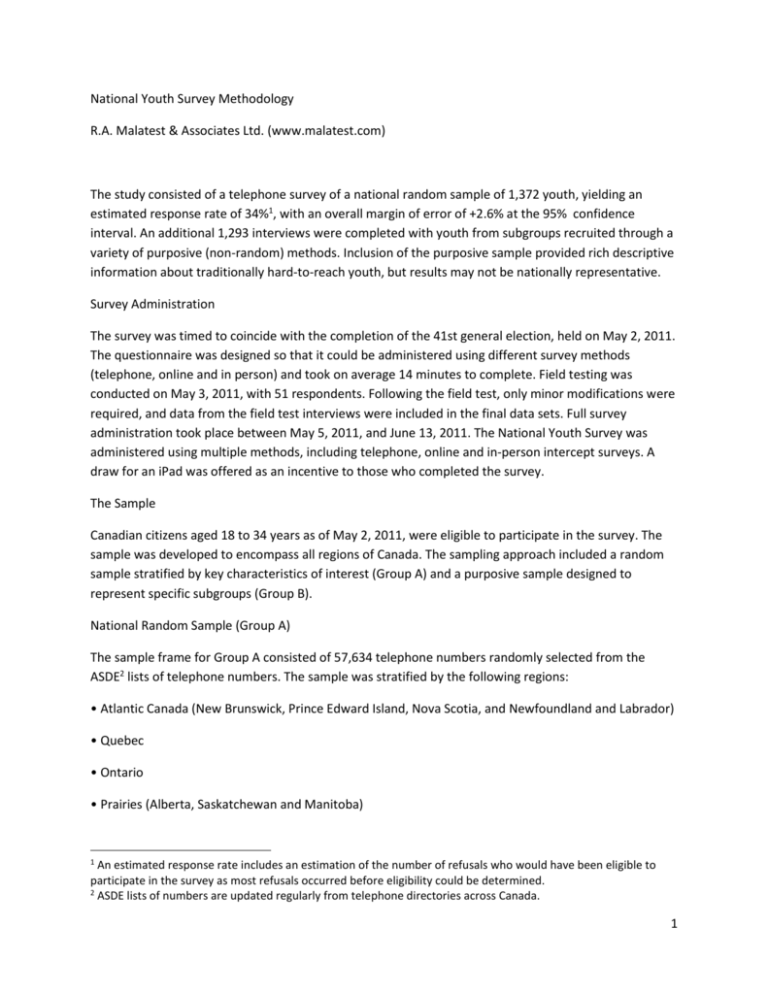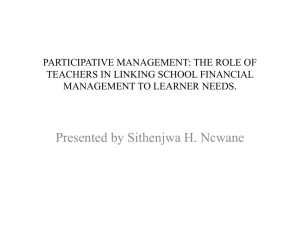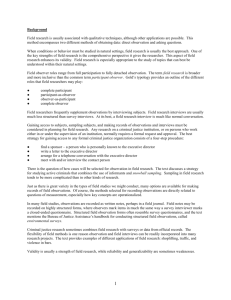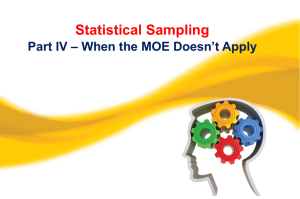National Youth Survey 2011 Methods
advertisement

National Youth Survey Methodology R.A. Malatest & Associates Ltd. (www.malatest.com) The study consisted of a telephone survey of a national random sample of 1,372 youth, yielding an estimated response rate of 34%1, with an overall margin of error of +2.6% at the 95% confidence interval. An additional 1,293 interviews were completed with youth from subgroups recruited through a variety of purposive (non-random) methods. Inclusion of the purposive sample provided rich descriptive information about traditionally hard-to-reach youth, but results may not be nationally representative. Survey Administration The survey was timed to coincide with the completion of the 41st general election, held on May 2, 2011. The questionnaire was designed so that it could be administered using different survey methods (telephone, online and in person) and took on average 14 minutes to complete. Field testing was conducted on May 3, 2011, with 51 respondents. Following the field test, only minor modifications were required, and data from the field test interviews were included in the final data sets. Full survey administration took place between May 5, 2011, and June 13, 2011. The National Youth Survey was administered using multiple methods, including telephone, online and in-person intercept surveys. A draw for an iPad was offered as an incentive to those who completed the survey. The Sample Canadian citizens aged 18 to 34 years as of May 2, 2011, were eligible to participate in the survey. The sample was developed to encompass all regions of Canada. The sampling approach included a random sample stratified by key characteristics of interest (Group A) and a purposive sample designed to represent specific subgroups (Group B). National Random Sample (Group A) The sample frame for Group A consisted of 57,634 telephone numbers randomly selected from the ASDE2 lists of telephone numbers. The sample was stratified by the following regions: • Atlantic Canada (New Brunswick, Prince Edward Island, Nova Scotia, and Newfoundland and Labrador) • Quebec • Ontario • Prairies (Alberta, Saskatchewan and Manitoba) 1 An estimated response rate includes an estimation of the number of refusals who would have been eligible to participate in the survey as most refusals occurred before eligibility could be determined. 2 ASDE lists of numbers are updated regularly from telephone directories across Canada. 1 • British Columbia • Northern Canada (Yukon, Northwest Territories and Nunavut) In total, 1,372 valid completions were obtained, yielding an estimated response rate of 34%.3 with an overall margin of error of +2.6% at the 95% confidence interval. The distribution of key demographic characteristics was compared with the national random sample (Group A) and the Canadian census of 2006. The slight differences in the distributions were corrected mathematically by post-stratification weighting by age and gender within the regions to reduce any potential bias caused by over- or under-sampling. Furthermore, response to the telephone survey was found to be biased toward youth with higher educational attainment. Sufficient census data were not available to adjust for these differences through the weighting strategy. As a result of these concerns, and in recognition of the interaction between education and many variables in the survey, the regression analyses controlled for education to ensure that the measured relationships between voting intention and the other variables were not merely an expression of respondents’ educational attainment. Full details of the sample, response rates and weighting are provided in Appendix A. Purposive Sample (Group B) Purposive sampling was used to provide data to construct profiles of the voting behaviours of different groups. The consultant used a variety of sampling approaches to better target these subgroups, including: • Telephone dialing to a sample of 11,511 phone numbers randomly selected from ASDE lists from census divisions that included an Aboriginal reserve – resulting in 296 completed interviews. • Telephone dialing to a list of 201 cellphone-only numbers purchased from ASDE – resulting in 14 completed interviews. • Distribution of a URL link to an online version of the survey through printing and distributing information cards, an advertisement on Facebook, distribution of information to relevant groups on Facebook and contacting 454 youth organizations to act as outlets for providing youth with information about the study – resulting in 305 completed interviews. • In-person intercept surveying in Victoria, Vancouver, Edmonton, Toronto, Ottawa and Montreal and surrounding districts – resulting in 714 completed interviews. The numbers of completed surveys by each of the subgroups are shown in following table. 3 An estimated response rate includes an estimation of the number of refusals who would have been eligible to participate in the survey as most refusals occurred before eligibility could be determined. 2 Number of Valid Completed Surveys by Mode of Completion for Subgroups Subgroup Aboriginal Youth with disabilities Ethnocultural Rural Unemployed Total Random (Group A) 87 52 196 372 69 776 Non-random (Group B) 196 101 262 180 172 911 Total 283 153 458 552 241 1,687 Analysis At the conclusion of the survey, data were entered and cleaned, open-ended responses were thematically coded and weights were applied to the required survey responses. The consultant then used the Statistical Package for the Social Sciences (SPSS, statistical analysis software) to produce the final survey results. Considerations The key strength of the study was the use of both random and purposive sampling. The random sample closely represented the national profile of youth in the 2006 census and therefore provided results that were reasonably nationally representative. The purposive sampling resulted in the inclusion of youth from subgroups who would not have been contacted by telephone sampling alone. Notwithstanding the strengths of the data obtained from the National Youth Survey, some limitations need to be considered when reading the results: • Non-response bias can occur. Post-stratification weighting was used to adjust for any small differences noted in age and gender. • The challenges of engaging with subgroups. While the inclusion of subgroups of youth in the survey who were contacted through non-random methods provides insight into the factors that influence voting behaviour, the findings may not be representative of the subgroup populations as a whole. • Survey respondents tend to over-report voter turnout. Slightly fewer than three quarters (74%) of surveyed youth reported that they had participated in the 2011 general election. These results should be considered with caution as self-identified voter turnout rates reported in surveys have consistently been found to be significantly higher than the official turnout rates,4and this is almost certainly the case 4 It is well known that surveys over-report voting “… in part because those who are less interested in politics and less inclined to vote are less prone to answer surveys … and in part because of misreporting due to social desirability.” André Blais, Elisabeth Gidengil, Richard Nadeau and Neil Nevitte, Anatomy of a Liberal Victory: Making Sense of the 2000 Canadian Election (Peterborough: Broadview Press, 2002), p. 61. 2000 Canadian Election (Peterborough: Broadview Press, 2002), p. 61. 3 with the National Youth Survey. However, studies show that over-reporting tends to affect all samples to some extent (regardless of subgroup) and that surveys can still be reliably used to identify factors associated with voting and non-voting. The survey also included a considerable sub-sample of selfreported non-voters, both in the national random sample (n=366) and in the sample of subgroups (n=731). 4









